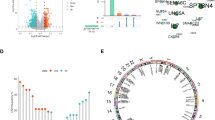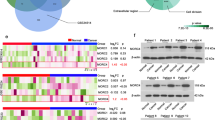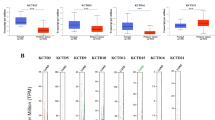Abstract
Sijunzi decoction (SJZD) is a traditional Chinese medicine prescription for the prevention and treatment of colorectal cancer. Our study is aimed to identify the potential therapeutic target of SJZD. Microarray analysis was performed on the patients with colorectal cancer under treatment of SJZD. The mRNA targets of SJZD were predicted by BATMAN-TCM database and were further identified by integrated analysis of expression data from TCGA. The correlation of gene expression and clinical characteristics was analyzed. Microarray analysis indicated that Krüppel-like factor 4 (KLF4) was significantly upregulated after intervention of SJZD. BATMAN-TCM prediction showed that KLF4 was an mRNA target of SJZD and it was downregulated in colorectal cancer by integrated analysis of expression data from TCGA. KLF4 may act as an administered indicator to assess whether adjuvant postoperative pharmaceutical therapy is needed for patients with colorectal cancer. Low KLF4 expression was significantly correlated with reductions of overall survival and recurrence rate. Our results suggested that KLF4 may be the potential therapeutic target of SJZD for the treatment of colorectal cancer.
This is a preview of subscription content, access via your institution
Access options
Subscribe to this journal
Receive 12 print issues and online access
$259.00 per year
only $21.58 per issue
Buy this article
- Purchase on Springer Link
- Instant access to full article PDF
Prices may be subject to local taxes which are calculated during checkout





Similar content being viewed by others
References
Stiefelhagen P . Prevention of colon carcinoma. Can herbal medicine prevent colon cancer? MMW Fortschr Med 2012; 154: 24.
An K, Jin-Rui G, Zhen Z, Xiao-Long W . Simultaneous quantification of ten active components in traditional Chinese formula Sijunzi Decoction using a UPLC-PDA method. J Anal Methods Chem 2014; 2014: 570359.
Hsiao WL, Liu L . The role of traditional Chinese herbal medicines in cancer therapy—from TCM theory to mechanistic insights. Planta Med 2010; 76: 1118–1131.
Liu Y, Yang J, Cai Z . Chemical investigation on Sijunzi decoction and its two major herbs Panax ginseng and Glycyrrhiza uralensis by LC/MS/MS. J Pharm Biomed Anal 2006; 41: 1642–1647.
Liu L, Han L, Wong DY, Yue PY, Ha WY, Hu YH et al. Effects of Si-Jun-Zi decoction polysaccharides on cell migration and gene expression in wounded rat intestinal epithelial cells. Br J Nutr 2005; 93: 21–29.
Guo JH, Chen G, Yang SQ, Wei MH, Chen X . Clinical observation of the role of Chenxia Sijunzi decoction in promoting the recovery of gastrointestinal function in critically ill patients. Zhongguo Wei Zhong Bing Ji Jiu Yi Xue 2012; 24: 674–676.
Lu Y, Lin H, Zhang J, Wei J, Sun J, Han L . Sijunzi decoction attenuates 2, 4, 6-trinitrobenzene sulfonic acid (TNBS)-induced colitis in rats and ameliorates TNBS-induced claudin-2 damage via NF-kappaB pathway in Caco2 cells. BMC Complement Altern Med 2017; 17: 35.
Wang Z, Peng Y, Li XB . Effect of Sijunzi decoction on the intestinal flora disturbance in two rat models of Pi-deficiency syndrome. Zhongguo Zhong Xi Yi Jie He Za Zhi 2009; 29: 825–829.
Liang C, Zhang SH, Cai ZD . Effects of early intestinal application of sijunzi decoction on immune function in post-operational patients of gastrointestinal tumor. Zhongguo Zhong Xi Yi Jie He Za Zhi 2005; 25: 1070–1073.
Wang L, Jiang Q, Hu J, Zhang Y, Li J . Research Progress on Chemical Constituents of Lonicerae japonicae flos. Biomed Res Int 2016; 2016: 8968940.
Tabas-Madrid D, Nogales-Cadenas R, Pascual-Montano A . GeneCodis3: a non-redundant and modular enrichment analysis tool for functional genomics. Nucleic Acids Res 2012; 40 (Web Server issue): W478–W483.
Ashburner M, Ball CA, Blake JA, Botstein D, Butler H, Cherry JM et al. Gene ontology: tool for the unification of biology. The Gene Ontology Consortium. Nat Genet 2000; 25: 25–29.
Kanehisa M, Goto S . KEGG: kyoto encyclopedia of genes and genomes. Nucleic Acids Res 2000; 28: 27–30.
Liu Z, Guo F, Wang Y, Li C, Zhang X, Li H et al. BATMAN-TCM: a Bioinformatics Analysis Tool for Molecular mechANism of Traditional Chinese Medicine. Sci Rep 2016; 6: 21146.
Gao J, Aksoy BA, Dogrusoz U, Dresdner G, Gross B, Sumer SO et al. Integrative analysis of complex cancer genomics and clinical profiles using the cBioPortal. Sci Signal 2013; 6: pl1.
Chen M, May BH, Zhou IW, Xue CC, Zhang AL . Meta-analysis of oxaliplatin-based chemotherapy combined with traditional medicines for colorectal cancer: contributions of specific plants to tumor response. Integr Cancer Ther 2016; 15: 40–59.
Sagar SM, Wong RK . Chinese medicine and biomodulation in cancer patients—part one. Curr Oncol 2008; 15: 42–48.
Shields JM, Christy RJ, Yang VW . Identification and characterization of a gene encoding a gut-enriched Kruppel-like factor expressed during growth arrest. J Biol Chem 1996; 271: 20009–20017.
Ghaleb AM, Nandan MO, Chanchevalap S, Dalton WB, Hisamuddin IM, Yang VW . Kruppel-like factors 4 and 5: the yin and yang regulators of cellular proliferation. Cell Res 2005; 15: 92–96.
McConnell BB, Ghaleb AM, Nandan MO, Yang VW . The diverse functions of Kruppel-like factors 4 and 5 in epithelial biology and pathobiology. Bioessays 2007; 29: 549–557.
Zhao W, Hisamuddin IM, Nandan MO, Babbin BA, Lamb NE, Yang VW . Identification of Kruppel-like factor 4 as a potential tumor suppressor gene in colorectal cancer. Oncogene 2004; 23: 395–402.
Yu T, Chen X, Zhang W, Li J, Xu R, Wang TC et al. Kruppel-like factor 4 regulates intestinal epithelial cell morphology and polarity. PLoS ONE 2012; 7: e32492.
Chen YS, Wang R, Dashwood WM, Lohr CV, Williams DE, Ho E et al. A miRNA signature for an environmental heterocyclic amine defined by a multi-organ carcinogenicity bioassay in the rat. Arch Toxicol 2017 (e-pub ahead of print; doi: 10.1007/s00204-017-1945-6).
Wang N, Liu ZH, Ding F, Wang XQ, Zhou CN, Wu M . Down-regulation of gut-enriched Kruppel-like factor expression in esophageal cancer. World J Gastroenterol 2002; 8: 966–970.
Wei D, Gong W, Kanai M, Schlunk C, Wang L, Yao JC et al. Drastic down-regulation of Kruppel-like factor 4 expression is critical in human gastric cancer development and progression. Cancer Res 2005; 65: 2746–2754.
Choi BJ, Cho YG, Song JW, Kim CJ, Kim SY, Nam SW et al. Altered expression of the KLF4 in colorectal cancers. Pathol Res Pract 2006; 202: 585–589.
Stone CD, Chen ZY, Tseng CC . Gut-enriched Kruppel-like factor regulates colonic cell growth through APC/beta-catenin pathway. FEBS Lett 2002; 530: 147–152.
Zhang W, Chen X, Kato Y, Evans PM, Yuan S, Yang J et al. Novel cross talk of Kruppel-like factor 4 and beta-catenin regulates normal intestinal homeostasis and tumor repression. Mol Cell Biol 2006; 26: 2055–2064.
Ghaleb AM, Elkarim EA, Bialkowska AB, Yang VW . KLF4 suppresses tumor formation in genetic and pharmacological mouse models of colonic tumorigenesis. Mol Cancer Res 2016; 14: 385–396.
Xu J, Lu B, Xu F, Gu H, Fang Y, Huang Q et al. Dynamic down-regulation of Kruppel-like factor 4 in colorectal adenoma-carcinoma sequence. J Cancer Res Clin Oncol 2008; 134: 891–898.
Lee HY, Ahn JB, Rha SY, Chung HC, Park KH, Kim TS et al. High KLF4 level in normal tissue predicts poor survival in colorectal cancer patients. World J Surg Oncol 2014; 12: 232.
Patel NV, Ghaleb AM, Nandan MO, Yang VW . Expression of the tumor suppressor Kruppel-like factor 4 as a prognostic predictor for colon cancer. Cancer Epidemiol Biomarkers Prev 2010; 19: 2631–2638.
Ghaleb AM, Laroui H, Merlin D, Yang VW . Genetic deletion of Klf4 in the mouse intestinal epithelium ameliorates dextran sodium sulfate-induced colitis by modulating the NF-kappaB pathway inflammatory response. Inflamm Bowel Dis 2014; 20: 811–820.
Leng Z, Tao K, Xia Q, Tan J, Yue Z, Chen J et al. Kruppel-like factor 4 acts as an oncogene in colon cancer stem cell-enriched spheroid cells. PLoS ONE 2013; 8: e56082.
Klijn C, Durinck S, Stawiski EW, Haverty PM, Jiang Z, Liu H et al. A comprehensive transcriptional portrait of human cancer cell lines. Nat Biotechnol 2015; 33: 306–312.
Abaan OD, Polley EC, Davis SR, Zhu YJ, Bilke S, Walker RL et al. The exomes of the NCI-60 panel: a genomic resource for cancer biology and systems pharmacology. Cancer Res 2013; 73: 4372–4382.
Acknowledgements
This study was supported by Natural Science Foundation of Xinjiang Uygur Autonomous Region (2012211A094).
Author information
Authors and Affiliations
Corresponding author
Ethics declarations
Competing interests
The authors declare no conflict of interest.
Additional information
Supplementary Information accompanies the paper on Cancer Gene Therapy website
Rights and permissions
About this article
Cite this article
Jie, Y., He, W., Yang, X. et al. Krüppel-like factor 4 acts as a potential therapeutic target of Sijunzi decoction for treatment of colorectal cancer. Cancer Gene Ther 24, 361–366 (2017). https://doi.org/10.1038/cgt.2017.25
Received:
Revised:
Accepted:
Published:
Issue Date:
DOI: https://doi.org/10.1038/cgt.2017.25
This article is cited by
-
Sijunzi Decoction Inhibits Stemness by Suppressing β-Catenin Transcriptional Activity in Gastric Cancer Cells
Chinese Journal of Integrative Medicine (2022)



